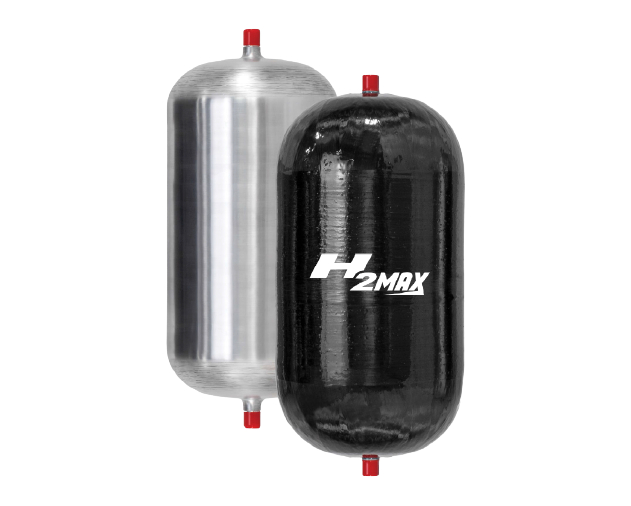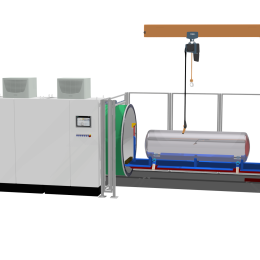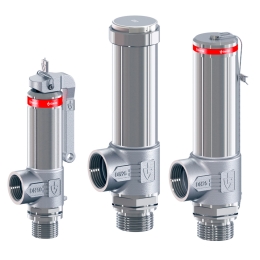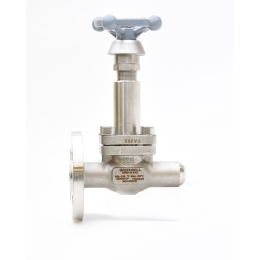- What is meant by hydrogen cryogenic storage?
- What are the different hydrogen storage technologies available on the market?
- Which design considerations are important for a state-of-the-art liquid hydrogen storage solution?
- Which are the key components of a liquid hydrogen storage system and which function do such components have?
- Which refrigerants are used to achieve such low temperatures of hydrogen?
- What are the main application areas of cryogenic hydrogen storage?
- The table below shows the main differences, pros & cons between liquid and gaseous hydrogen storage.
- Pros & cons of liquid hydrogen storage tanks
- Pros & cons of gaseous hydrogen storage tanks
- How is the liquid hydrogen transformed into gaseous hydrogen prior to its consumption in the fuel cell stack?
- Which are the purity levels for liquid hydrogen?
- What is green liquid hydrogen?
- What are the main working parameters of cryogenic hydrogen storage?
- Which components are needed to make a cryogenic hydrogen system safe?
- Which are the international standards/norms/certifications a liquid hydrogen storage solution needs to comply with?
- Do liquid hydrogen refueling station and nozzles exist and what are the safety considerations?
- Can cryogenic hydrogen storage be used for hydrogen transportation?
- Cryogenic hydrogen tanks for use in hydrogen trucks
- How much active cooling is needed to properly store liquid hydrogen?
Browse hundreds of components from leading suppliers for fuel cell systems on our marketplace!
What is meant by hydrogen cryogenic storage?
Cryogenic hydrogen storage is a system to store the hydrogen in liquid form while achieving a temperature of about -253°C at 1 atm pressure. The reason for storing the hydrogen at cryogenic temperature is its density which allows us to store more energy in small volume. But it is always a challenge to store the hydrogen at cryogenic temperature because of material embrittlement at such low temperature as well as hydrogen embrittlement. Some special austenitic stainless steels have shown good resistance against the hydrogen embrittlement at such temperatures, which has reduced the problem of embrittlement. Another challenge for cryogenic hydrogen storage is the insulation required at this temperature. Generally, superinsulation will be used for insulation purposes as it provides less boil-off. The superinsulation is nothing but a multi-layered insulation (aluminum foil + fiber glass paper) in presence of below 1 micron vacuum which arrests all three modes of heat transfer (Conduction, Convection and Radiation) from ambient temperature to -253°C.
What are the different hydrogen storage technologies available on the market?
As we know hydrogen has a very high calorific value (1,43,000 kJ/kg) with zero carbon emission. The world is looking towards using it as an alternative fuel. But due to low density and being highly flammable, the energy storage of hydrogen is always a challenge when attempting to obtain a higher energy-to-volume ratio. Different companies have developed different types of hydrogen tanks and storage systems to increase the energy-to-volume ratio.
Gaseous storage of hydrogen at high pressure is currently being used for commercial fuel cell vehicles. Type-IV and type-V pressure vessels are being used to store gaseous hydrogen at 35 MPa / 70 MPa at ambient temperature.
Toyota, in cooperation with select partner companies, has also developed a vessel for cryo-compressed hydrogen storage which allows for storage of hydrogen at higher energy-to-volume ratios at -40°C and high pressure.
Liquid hydrogen storage tanks have also been developed by different companies for different storage capacities at various pressures. This is mostly useful for static storage systems, but with the help of some developed technologies like cryogenic cooling, some companies have started manufacturing ISO tanks for liquid hydrogen transportation purposes.
The solid state hydrogen storage system is another option for storing hydrogen in metal hydride powder but this has not been widely adopted mostly because of the shorter life cycle.
Which design considerations are important for a state-of-the-art liquid hydrogen storage solution?
For the cryogenic tank design within a liquid hydrogen storage system, several factors and parameters need to be taken into consideration to achieve a maximum safety level. The design considerations for a cryogenic liquid hydrogen storage tank are as follows:
- Design Pressure
- MAWP (Maximum allowable working pressure)
- Operating pressure
- Orientation (vertical or horizontal)
- Design code
- Foundation design
- Support system design
Which are the key components of a liquid hydrogen storage system and which function do such components have?
To store hydrogen in liquid form in a cryogenic storage vessel at 1 atm pressure and -253 °C some essential components are required to eliminate the heat leakage and for making the storage effective. The various components of the storage system used to fill, store and withdraw fuel in a hydrogen storage tank are:
- Inner vessel
- Outer vessel
- Insulation
- Valves
- Pressure building unit (PBU)
- Support
- VJP (Vacuum Jacketed Pipe )
- Vertex Breaker
- Cryo-cooler
a) Inner vessel
The inner vessel is mostly cylindrical in shape and contains the operating medium, namely hydrogen fuel. The inner vessel should be maintained at the cryogenic temperature required to store the liquid. The inner vessel is the component directly in contact with the actual hydrogen fuel. So, the material of the inner vessel is selected based on the cryogenic temperatures.
b) Outer vessel
The Outer vessel acts as a casing for the inner vessel. The inner vessel is mounted inside the outer vessel by using support plates. The main function of the outer vessel is to hold the vacuum and provide good insulation to the inner vessel by reducing or eliminating heat leakage.
c) Valves
Valves are essential components of cryogenic hydrogen storage systems in order to facilitate the transfer of the hydrogen fuel to and from the tank. Different valves are used based on their application. These cryogenic valves are used to meet design requirements:
- Globe valves
- Diverter Valves
- Safety Valves
- Pressure Relief Valves.
d) Pressure building unit
The pressure building unit works as a heat exchanger. During the fluid withdrawal there is a pressure drop inside the vessel. When there is a pressure drop inside the vessel, the saturation temperature of the fluid at the operating pressure is reduced, resulting in the conversion of liquid to gas. Additionally, the pressure drop creates reduction in mass flow rate of the withdrawal of liquid. The PBU (Pressure building unit) extracts some liquid from the discharge line of the vessel and converts the cryogenic liquid into the required cryogenic vapor and recirculates it to the vessel to maintain the required operating pressure.
e) VJP (Vacuum Jacketed Pipe)
At a cryogenic temperature of -253°C or 20K, liquid hydrogen is transferred in insulated transfer lines. If we utilize regular pipes, the heat transmission from the ambient environment to the fluid is very high, causing the fluid to boil off. Vacuum-jacketed pipe or vacuum insulated transfer piping is utilized specifically to address this issue.
Which refrigerants are used to achieve such low temperatures of hydrogen?
Hydrogen has a boiling point of -253°C at 1 bar. For the refrigeration of hydrogen, we need liquids or gases of low boiling point to achieve this low temperature of hydrogen. Since we cannot reach that temperature directly, several stages are to be completed in order to achieve such a low hydrogen temperature. Helium and nitrogen are the most frequent refrigerants used to achieve such low temperatures. Other refrigerants, such as mixtures of nitrogen, methane, ethane, propane, and n-butane, can be used to achieve temperatures as low as 114 K.
What are the main application areas of cryogenic hydrogen storage?
Hydrogen cryogenic storage has a wide scope of applications in this present world. Cryogenic hydrogen is widely used for space flight, while liquid hydrogen is used as fuel for space jets and FCEV (Fuel cell electrical vehicles) such as vehicles, buses, trucks, and so on. The primary applications for cryogenic hydrogen storage systems are:
- Refueling stations
- Aerospace stations
- Automotive applications

The table below shows the main differences, pros & cons between liquid and gaseous hydrogen storage.
| Topics | Liquid Hydrogen Storage | Gaseous Hydrogen Storage |
| Density | 70.899 kg/m3 at atm pressure | 1.3164 kg/m3 at atm pressure |
| Insulation | Required | Not required |
| Cost | Expensive | Less |
| Pressure | Less increment of pressure | More increment of pressure |
| Boil-off | High Boil-off | No Boil-off |
Pros & cons of liquid hydrogen storage tanks
| Advantages of liquid hydrogen storage | Drawbacks of liquid hydrogen storage |
| High volume and density | Required insulation |
| Less pressure | More boil-off |
| Less hazard due to less pressure | More equipment required to maintain liquid storage |
Pros & cons of gaseous hydrogen storage tanks
| Advantages of gaseous hydrogen storage | Drawbacks of gaseous hydrogen storage |
| Insulation not required | More hazards due to high pressure |
| Less expensive & ready to use | More thickness is required |
| No boil-off | Less volume and density |
How is the liquid hydrogen transformed into gaseous hydrogen prior to its consumption in the fuel cell stack?
Hydrogen is stored in liquid state using cryo-compression to achieve higher storage capacity. But in some applications like fuel cells, the inlet hydrogen need to be in gaseous form. To convert the liquid hydrogen into gaseous hydrogen a cryogenic vaporizer is used. Cryogenic vaporizers are phase-changing devices which turn liquid hydrogen into gaseous hydrogen at desired pressure and temperature.
Which are the purity levels for liquid hydrogen?
Hydrogen is available in many physical and chemical forms, but the interest is how it is separated from the parental forms. The separation of hydrogen from the parental form is the generation of hydrogen. The purity level of the hydrogen is based on the production methods, namely, the means of hydrogen production used for extraction of hydrogen from its parental forms. In general, there are three types or purity levels of hydrogen gas: pure hydrogen, which has a purity of 99.99%, highly pure hydrogen, which has a purity level of 99.999%, and ultra-pure hydrogen, which has a purity level of 99.9999%.
What is green liquid hydrogen?
The green hydrogen is the hydrogen produced by splitting water by electrolysis. The energy sources include solar, wind, and hydro. This hydrogen is known as green hydrogen. Green liquid hydrogen is the hydrogen which is liquefied using energy from renewable sources. No greenhouse emissions are emitted during the green hydrogen storage process. The same renewable energy sources are used throughout the process in various stages such as cryogenic cooling, driving the cryogenic hydrogen compressor, and other processes required to generate green cryo-compressed hydrogen.
What are the main working parameters of cryogenic hydrogen storage?
The working parameters of a cryogenic hydrogen storage tank is classified as:
a) Operating system behavior
- Filling (bottom filling and top filling)
- Level gauge
- Trycock line
b) State of the withdrawal line or working condition
- PBU (Pressure building unit)
- Vaporizer
- Cryo pump
Which components are needed to make a cryogenic hydrogen system safe?
Many existing and emerging applications of hydrogen involve use of hydrogen in the gaseous form. However, there are important applications that use hydrogen as a liquid. All the safety considerations and hazards related to gaseous hydrogen also apply to liquid hydrogen because of the ease with which it evaporates. The components that are used to make a cryogenic system safe are:
- Vessel safety relief valve
- Line safety relief valve
- Flame detector
- Smoke detector
- Hydrogen leak detector
- Ultrasonic leak detector
- Ventilation
- Fire/Explosion
- Vent stack
- Hydrogen sensors
- Fencing
Which are the international standards/norms/certifications a liquid hydrogen storage solution needs to comply with?
The international standards and certifications for the hydrogen storage system are
- ASME Boiler and pressure vessel code section VIII
- US DOT (Department of Transportation) specifications and regulations
- NFPA (National fire protection association)
- ISO standards
- CGA (Compressed gas association)
Do liquid hydrogen refueling station and nozzles exist and what are the safety considerations?
The hydrogen is used in automobile applications for fuel cell. The hydrogen is stored in a tank. This tank is refilled at the hydrogen refueling station. The hydrogen dispensers are used to deliver the liquid hydrogen to the fuel storage tanks. There are many safety considerations that need to the practiced.
a) Safety considerations for refueling stations
- Fire safety
- Leakage safety
- Storage safety
- Dispensing safety
b) Safety considerations for the dispensing nozzle
- Perfect interaction of vehicle nozzle and dispenser nozzle is required
- Wear and tear (abrasion) considerations of nozzle
- Pressure drops
- Escaping of fuel at nozzle outlet
Can cryogenic hydrogen storage be used for hydrogen transportation?
The cryogenic storage tank is one of the major application for the transport of liquid hydrogen. Compared to gaseous hydrogen, liquid hydrogen can be stored in high capacity in the same volume. Liquid hydrogen can accommodate more capacity. For the transport of hydrogen, a cryogenic storage tank is widely used so that more capacity of hydrogen can be transported in less space compared gases hydrogen.
Cryogenic hydrogen tanks for use in hydrogen trucks
a) What are the advantages and which challenges still need to be overcome?
Hydrogen trucks are vehicles which use hydrogen as a fuel. A hydrogen onboard fuel tank is integrated into the truck. The engines used in hydrogen trucks run on hydrogen fuel.
b) There are many advantages for hydrogen trucks
- Zero carbon emission
- Abundantly available
- Fast refueling
c) Challenges to overcome
- Weight and volume
- Efficiency
- Durability
- Refueling time
- Cost
- Life cycle and efficiency analysis
How much active cooling is needed to properly store liquid hydrogen?
a) Is it possible to calculate the energy required to keep the hydrogen in liquid form?
Any liquid or gas will change the phase by using heat is known as latent heat. The energy can be calculated using heat transfer equations. So a substance phase change would occur due to latent heat being present. In a cryogenic hydrogen storage tank, the latent heat inside the tank needs to be removed to avoid the phase change from liquid to gas. The latent heat is removed by active cooling, also known as cryogenic cooling, of the liquid hydrogen. For this active cooling of liquid hydrogen to constantly remove latent heat of evaporation a cryocooler is used which supplies the required temperature to keep the latent heat of vaporization from accumulating. The medium will thus be in liquid form only.
b) Is hydrogen leakage a problem in cryogenic hydrogen storage systems?
Liquid hydrogen in a cryogenic hydrogen storage system absorbs heat from the surroundings. Due to this absorbed heat leakage, the liquid hydrogen turns into gaseous hydrogen. One must be aware that liquefying of hydrogen is very expensive, since hydrogen has a superior thermal conductivity compared to other gases. Additionally, the insulation of the cryo-compressed storage system will be harmed if there is a hydrogen leak. Superinsulation, for instance, costs more and is constructed of fiber glass paper and aluminum foil. Maintaining a leak-free cryogenic hydrogen storage system is preferable or useful for preventing such problems. If there is a gas leak in a cryogenic hydrogen storage tank the liquid hydrogen will turn into gaseous hydrogen due to boil-off. This will reduce the capacity of the tank and likewise creates an explosion hazard. Therefore, arresting of leakage of the tank is of utmost importance.
Last update: 13.01.2023







